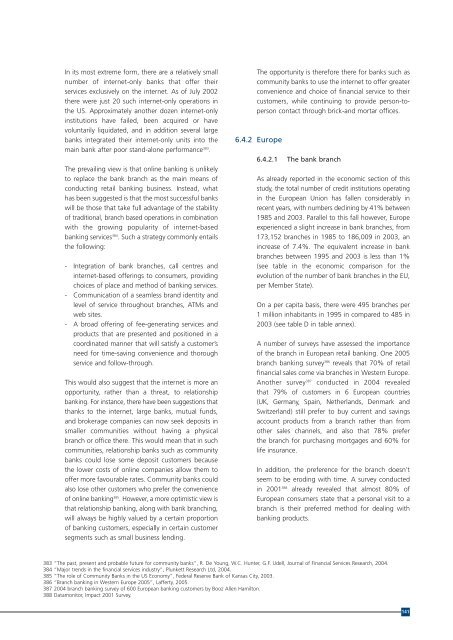A comparative analysis of the US and EU retail banking markets - Wsbi
A comparative analysis of the US and EU retail banking markets - Wsbi
A comparative analysis of the US and EU retail banking markets - Wsbi
Create successful ePaper yourself
Turn your PDF publications into a flip-book with our unique Google optimized e-Paper software.
In its most extreme form, <strong>the</strong>re are a relatively small<br />
number <strong>of</strong> internet-only banks that <strong>of</strong>fer <strong>the</strong>ir<br />
services exclusively on <strong>the</strong> internet. As <strong>of</strong> July 2002<br />
<strong>the</strong>re were just 20 such internet-only operations in<br />
<strong>the</strong> <strong>US</strong>. Approximately ano<strong>the</strong>r dozen internet-only<br />
institutions have failed, been acquired or have<br />
voluntarily liquidated, <strong>and</strong> in addition several large<br />
banks integrated <strong>the</strong>ir internet-only units into <strong>the</strong><br />
main bank after poor st<strong>and</strong>-alone performance 383 .<br />
The prevailing view is that online <strong>banking</strong> is unlikely<br />
to replace <strong>the</strong> bank branch as <strong>the</strong> main means <strong>of</strong><br />
conducting <strong>retail</strong> <strong>banking</strong> business. Instead, what<br />
has been suggested is that <strong>the</strong> most successful banks<br />
will be those that take full advantage <strong>of</strong> <strong>the</strong> stability<br />
<strong>of</strong> traditional, branch based operations in combination<br />
with <strong>the</strong> growing popularity <strong>of</strong> internet-based<br />
<strong>banking</strong> services 384 . Such a strategy commonly entails<br />
<strong>the</strong> following:<br />
- Integration <strong>of</strong> bank branches, call centres <strong>and</strong><br />
internet-based <strong>of</strong>ferings to consumers, providing<br />
choices <strong>of</strong> place <strong>and</strong> method <strong>of</strong> <strong>banking</strong> services.<br />
- Communication <strong>of</strong> a seamless br<strong>and</strong> identity <strong>and</strong><br />
level <strong>of</strong> service throughout branches, ATMs <strong>and</strong><br />
web sites.<br />
- A broad <strong>of</strong>fering <strong>of</strong> fee-generating services <strong>and</strong><br />
products that are presented <strong>and</strong> positioned in a<br />
coordinated manner that will satisfy a customer’s<br />
need for time-saving convenience <strong>and</strong> thorough<br />
service <strong>and</strong> follow-through.<br />
This would also suggest that <strong>the</strong> internet is more an<br />
opportunity, ra<strong>the</strong>r than a threat, to relationship<br />
<strong>banking</strong>. For instance, <strong>the</strong>re have been suggestions that<br />
thanks to <strong>the</strong> internet, large banks, mutual funds,<br />
<strong>and</strong> brokerage companies can now seek deposits in<br />
smaller communities without having a physical<br />
branch or <strong>of</strong>fice <strong>the</strong>re. This would mean that in such<br />
communities, relationship banks such as community<br />
banks could lose some deposit customers because<br />
<strong>the</strong> lower costs <strong>of</strong> online companies allow <strong>the</strong>m to<br />
<strong>of</strong>fer more favourable rates. Community banks could<br />
also lose o<strong>the</strong>r customers who prefer <strong>the</strong> convenience<br />
<strong>of</strong> online <strong>banking</strong> 385 . However, a more optimistic view is<br />
that relationship <strong>banking</strong>, along with bank branching,<br />
will always be highly valued by a certain proportion<br />
<strong>of</strong> <strong>banking</strong> customers, especially in certain customer<br />
segments such as small business lending.<br />
The opportunity is <strong>the</strong>refore <strong>the</strong>re for banks such as<br />
community banks to use <strong>the</strong> internet to <strong>of</strong>fer greater<br />
convenience <strong>and</strong> choice <strong>of</strong> financial service to <strong>the</strong>ir<br />
customers, while continuing to provide person-toperson<br />
contact through brick-<strong>and</strong> mortar <strong>of</strong>fices.<br />
6.4.2 Europe<br />
6.4.2.1 The bank branch<br />
As already reported in <strong>the</strong> economic section <strong>of</strong> this<br />
study, <strong>the</strong> total number <strong>of</strong> credit institutions operating<br />
in <strong>the</strong> European Union has fallen considerably in<br />
recent years, with numbers declining by 41% between<br />
1985 <strong>and</strong> 2003. Parallel to this fall however, Europe<br />
experienced a slight increase in bank branches, from<br />
173,152 branches in 1985 to 186,009 in 2003, an<br />
increase <strong>of</strong> 7.4%. The equivalent increase in bank<br />
branches between 1995 <strong>and</strong> 2003 is less than 1%<br />
(see table in <strong>the</strong> economic comparison for <strong>the</strong><br />
evolution <strong>of</strong> <strong>the</strong> number <strong>of</strong> bank branches in <strong>the</strong> <strong>EU</strong>,<br />
per Member State).<br />
On a per capita basis, <strong>the</strong>re were 495 branches per<br />
1 million inhabitants in 1995 in compared to 485 in<br />
2003 (see table D in table annex).<br />
A number <strong>of</strong> surveys have assessed <strong>the</strong> importance<br />
<strong>of</strong> <strong>the</strong> branch in European <strong>retail</strong> <strong>banking</strong>. One 2005<br />
branch <strong>banking</strong> survey 386 reveals that 70% <strong>of</strong> <strong>retail</strong><br />
financial sales come via branches in Western Europe.<br />
Ano<strong>the</strong>r survey 387 conducted in 2004 revealed<br />
that 79% <strong>of</strong> customers in 6 European countries<br />
(UK, Germany, Spain, Ne<strong>the</strong>rl<strong>and</strong>s, Denmark <strong>and</strong><br />
Switzerl<strong>and</strong>) still prefer to buy current <strong>and</strong> savings<br />
account products from a branch ra<strong>the</strong>r than from<br />
o<strong>the</strong>r sales channels, <strong>and</strong> also that 78% prefer<br />
<strong>the</strong> branch for purchasing mortgages <strong>and</strong> 60% for<br />
life insurance.<br />
In addition, <strong>the</strong> preference for <strong>the</strong> branch doesn’t<br />
seem to be eroding with time. A survey conducted<br />
in 2001 388 already revealed that almost 80% <strong>of</strong><br />
European consumers state that a personal visit to a<br />
branch is <strong>the</strong>ir preferred method for dealing with<br />
<strong>banking</strong> products.<br />
383 “The past, present <strong>and</strong> probable future for community banks”, R. De Young, W.C. Hunter, G.F. Udell, Journal <strong>of</strong> Financial Services Research, 2004.<br />
384 “Major trends in <strong>the</strong> financial services industry”, Plunkett Research Ltd, 2004.<br />
385 “The role <strong>of</strong> Community Banks in <strong>the</strong> <strong>US</strong> Economy”, Federal Reserve Bank <strong>of</strong> Kansas City, 2003.<br />
386 “Branch <strong>banking</strong> in Western Europe 2005”, Lafferty, 2005.<br />
387 2004 branch <strong>banking</strong> survey <strong>of</strong> 600 European <strong>banking</strong> customers by Booz Allen Hamilton.<br />
388 Datamonitor, Impact 2001 Survey.<br />
141
















